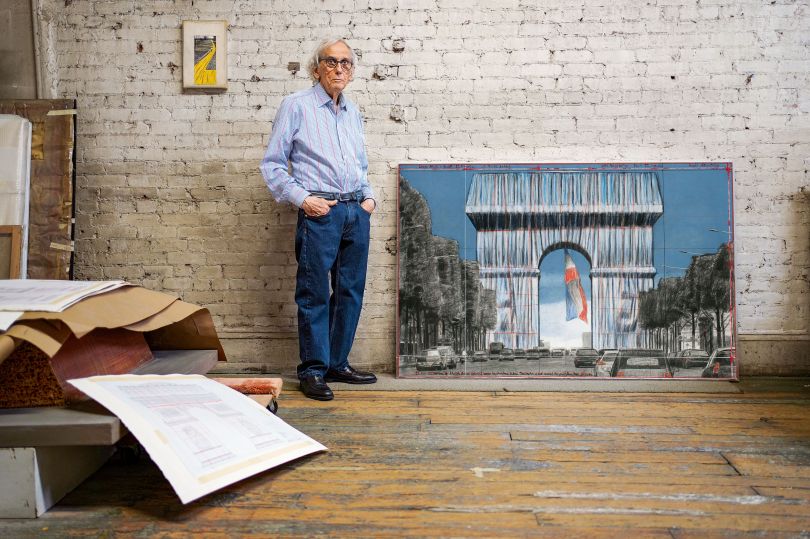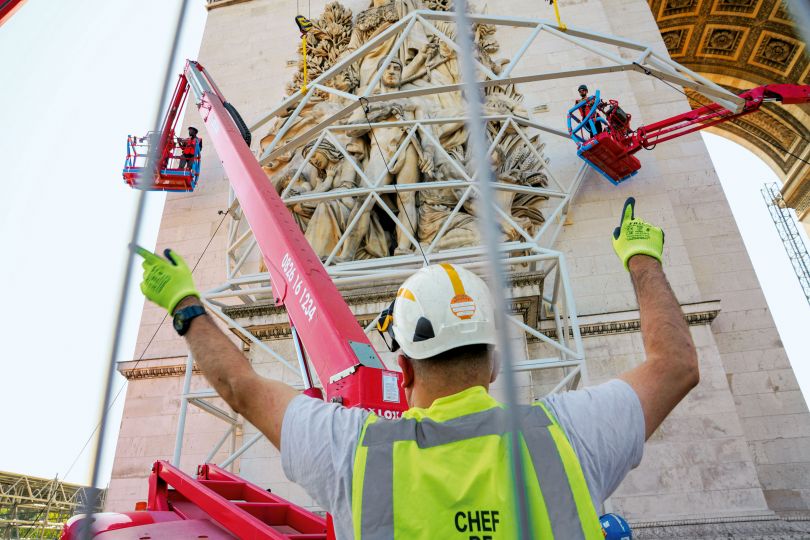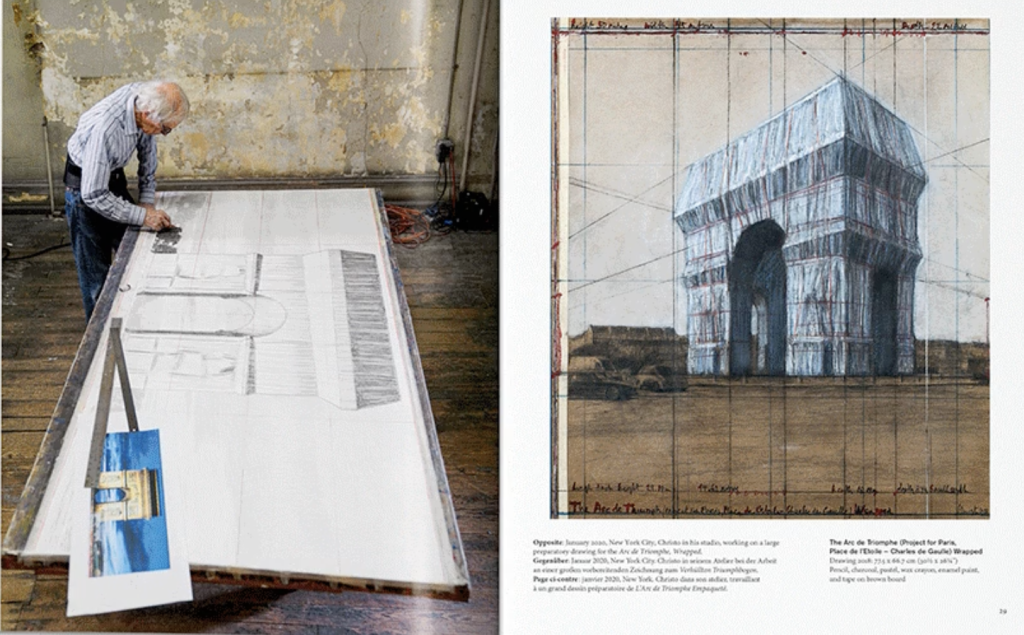Introduction
For more than fifty years, the renowned artists Christo and Jeanne-Claude dreamed of covering the famous Arc de Triomphe in cloth. To cover the Arc de Triomphe with 25,000 square meters of red tobacco and polypropylene cloth to evoke the sacrifices of the French people, and its marries history. This show ambitious to the bones is now considered as one of the greatest artistic feats of this decade.
It all started with the artistic journey of Christo and Jeanne-Claude, spanning continents and breaking conventions on its way. Conceived in 1962 as little more than a dream while the pair were renting a studio close to the monument, it has since become something of an obsession and was completed despite record levels of opposition from every level of American bureaucracy after Jeanne-Claude’s death five years ago. Instead, after unexpectedly being green-lit to get the thing made in 2018, then losing him in 2020, the prospective realization of their once-distant dream only swelled.
This initial inquiry into their creative progression tells the history of Christo and Jeanne-Claude’s vision, which finally lives in the upcoming Arc de Triomphe renovation. While it stands to honour France’s narrative, the iconic monument prepares to ‘adorn itself in a gown of light’, becoming a timeless canvas for artistic creativity and freedom.
Historical Prelude: Christo and Jeanne-Claude’s Artistic Journey
The plans for the Arc de Triomphe began in the collective imagination of Christo Vladimirov Javacheff and Jeanne-Claude Denat de Guillebon, known among all simply as Christo e Jeanne-Claude. Although certainly not an option in their wildest dreams when they first envisioned the idea of enclosing the monument in 1962. Instead, the artistic pair went on to do a number of large-scale site-specific works across the world, such as ‘The Pont Neuf Wrapped’ (1985) and in 1995, they packed the German ‘Wrapped Reichstag.’.

The Long-Awaited Dream: A Chronology of Persistence
Despite setbacks and hurdles, the dream of encapsulating the Arc de Triomphe remained. The artist’s plan — he lost his wife and artistic collaborator Jeanne-Claude in 2009 — won approval in 2018 against all odds. Unfortunately the artist died in May 2020, but his long-held dream has at last seen the light of day. Be-decked in recyclable polypropylene fabric and a red rope, the Arc de Triomphe was due to be wrapped for 16 days from September 18-October 3, 2021. Concurrently, an exhibition at Sotheby’s Paris titled ‘The Final Christo’ offered 25 works that tell the story of this massive undertaking.
Artistic Freedom Unleashed: Christo’s Visionary Philosophy
In his last interview to Centre Pompidou magazine, Christo described the project as “absolutely irrational, total freedom. “. He called it unnecessary but celebratory, part of the blank canvas where a painter instinctively selects his colors. Christo saw the wrapping of a monument as an expression both of the joy of liberty in a society beyond justification
A Scream of Freedom: Christo’s Personal Connection
It is evident here that Christo’s meaningful relationship with the theme of freedom emerged from his own lived experience. After illegally made his way into Austria, he had just tasted the yoke of the Soviet system in Bulgaria. The project is best encapsulated in his own words: “Our work of art is a scream of freedom”. — This has epitomized his life-long dedication to the values of liberty.
Nomadic Tribes and Temporary Beauty: Symbolism of Freedom
The ephemeral quality of Christo’s monumental works chimes with the freedom it signifies. He likened it to nomadic tribes who build ‘hardened’ monuments in the rain as if symbolic of human resistance facing down nature. And like art, the literature is constantly changing symbolizing how freedom should also keep being created and safeguarded.
Timeliness in Expression: A Message for Contemporary Challenges
The timing of the project communicates to some degree to current threats and obstructions experienced in art space. This era of art censure or defensiveness is also a reminder indeed that Christo has continued his creative life without flinching or fear. Above all the project does not concede to the idea of bargaining over fundamental rights and freedoms.
Practical Fight for Freedom: Christo and Jeanne-Claude’s Legacy
Aside from exploring their craft, Christo and Jeanne-Claude were also committed to guaranteeing that the public art be available for all. This means they prevented external entities to manipulate their creative processes by financing their works on their own. They hover at a remove from the grasping horizons of commerce, and maintain that their work is only ever provisional.
A Worthy Tribute: The Wrapping of Arc de Triomphe
Perhaps the most topical and least political, their public Art Offering: L’Arc de Triomphe le Project is under better scrutiny; a million tomorrows wrenching from an old world already gone or melted to the ground on account of velocity.Down Among The Wine-cups July 2000pass the Leatherfor the Sore Thumb Toprope Pentagonand no more photo-preach circuit-automatic-easelundercut clean breast anthemno long form booming tractor-road bellow. The relevance of the project, becomes an important angle that offers to render it more hushed and which, also helps extract reflections on the wider current social scenario.

Wrapped up, however, the memorial serves as a metaphor for free speech as an hour world debates censorship, creative freedom and what rights we hold sacred. Even though artists are often censored or dropped for being “offensive” by platforms, Christo only realized that the handshake is more than we need and asks society to accept an additional thing as a new symbol of liberation. In wrapping a monument in cloth, this trivial act instantly transforms to a powerful proclamation of the right to write — write freely.
Moreover, the impermanence of Christo’s work (like bringing a material to heaven) resemble this nomadic nature of freedom. The artist himself underscores the force required to resist external pressure and compares it with nomadic tribes. The ephemeral entombment of the monument with alternating degrees of toughness symbolises liberty as a fleeting yet robust commodity in an age when absolute truth is occasionally traded for permissible liberties.
At a time when the world is confronted by threats exceeding the bounds of individual freedoms, that shrouded Arc de Triomphe serves as an emblem for reminding us just how important it is not to leave the fight for liberty asleep. It gives a new meaning to the rather stately legacy Christo and Jeanne-Claude left behind, of funding their vast works themselves so as not to be beholden to any third parties in preserving their independence. Theres also a challenge to social norms, but all in dedication towards the longevity of public art free from governmental intervention and manufacturer interest.
The wrapped Arc de Triomphe transcends the purely aesthetic, offering a symbolic plea for who we are and what we value in our newly unlocked world, one where basic freedoms are felt to be at stake. In his final interview—archival audio from our 2018 story on him—the artist reflects on the freedom to create and pursues irrational goals.
Christo and Jeanne-Claude’s wrapped Arc de Triomphe opens to public in Paris Courtesy: Deezeen
Conclusion: A Monumental Ode to Freedom
In a world where artistic expression and freedom are hotly debated, the Wrapped Arc de Triomphe stands out as a colossal tribute to liberty. Christo’s vision, realised after his death, is proof of the art’s eternal ability to honour and defend the values of illogical freedom. The Arc de Triomphe sheds its temporary veil to represent the eternal expression of artistic liberty as well as the historical sacrifices made by France.
Feature Image: Christo and Jeanne-Claude. L’Arc de Triomphe, Wrapped is published by Taschen © Christo and Jeanne-Claude Foundation, New York





